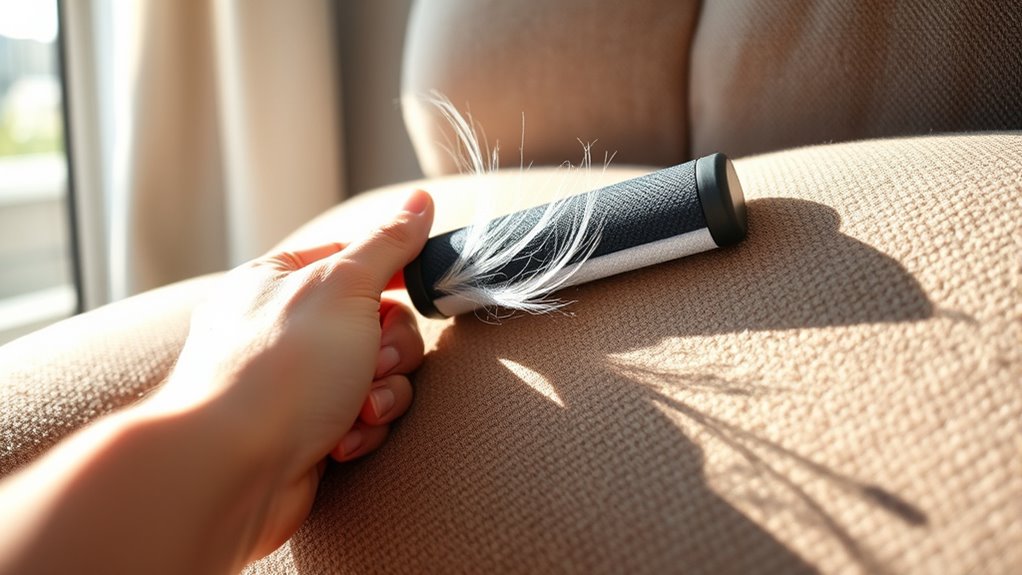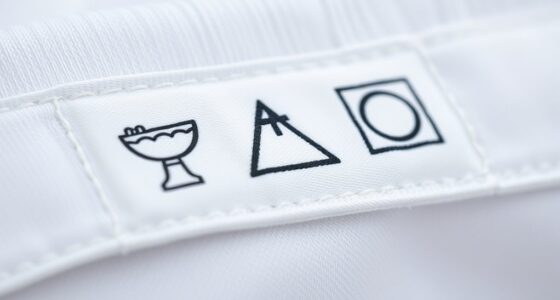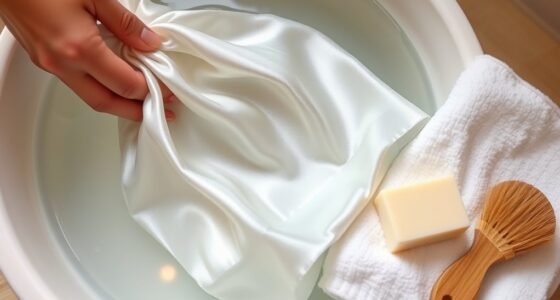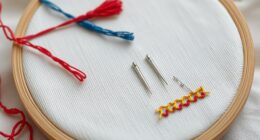To remove pet hair from clothes and upholstery, start by using a lint roller or rubber gloves to lift loose hair easily. Add fabric softener to your laundry or spray a diluted softener on upholstery to loosen stubborn hair. Vacuum surfaces thoroughly with a brush attachment, focusing on high-traffic areas. Damp sponges and dryer sheets can also help pull hair away and reduce static cling. Keep exploring for more tips to keep your home hair-free.
Key Takeaways
- Use dampened fabric softener sprays or dryer sheets to loosen pet hair from clothes and upholstery.
- Employ rubber gloves or lint rollers to quickly lift pet hair from fabrics and furniture.
- Vacuum furniture and upholstery with brush attachments, going over surfaces multiple times from different angles.
- Regularly clean vacuum filters and brushes to maintain effective pet hair removal.
- Wash clothes with fabric softener or add dryer sheets to reduce static and prevent hair from sticking.
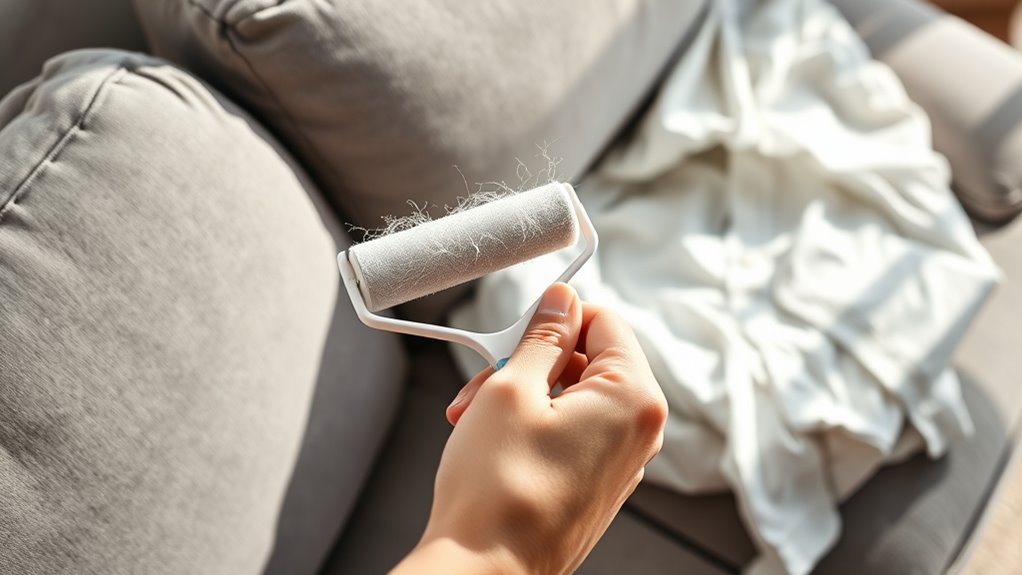
Have pet hair constantly taken over your furniture and clothing? If so, you’re not alone. Pet hair clings stubbornly to fabric surfaces, making it a challenge to keep everything looking tidy. The good news is that with the right vacuum techniques, you can considerably reduce the amount of hair that accumulates. Use a vacuum cleaner equipped with a brush or upholstery attachment—these are especially effective at lifting hair from furniture, curtains, and car seats. Make sure to go over surfaces multiple times from different angles to loosen embedded hair, and don’t forget to adjust the suction power for delicate fabrics. Regularly cleaning your vacuum filter and brush will maintain its effectiveness, preventing hair from just being pushed around instead of removed.
In addition to vacuum techniques, fabric softeners can be surprisingly helpful in tackling pet hair. When washing clothes or bedding, add a small amount of fabric softener or use dryer sheets. These products coat fibers in a way that prevents pet hair from sticking tightly, making it easier to remove during the laundry process. For clothes that are already covered in hair, try dampening them slightly before brushing or using a lint roller—this helps loosen hair, and fabric softeners can make that process smoother. When drying, tossing in a dryer sheet can also help reduce static and prevent hair from clinging to the fabric afterward. If you’re dealing with upholstery, applying a fabric softener diluted in water with a spray bottle can loosen pet hair, making it easier to wipe away with a cloth or brush.
Another effective approach involves maintaining a regular cleaning routine to prevent hair buildup. Frequent vacuuming, especially in high-traffic pet areas, keeps hair from embedding deep into fibers. Using specialized pet hair removers, like rubber gloves or lint rollers, can quickly pick up loose hair from clothes and furniture. For stubborn hair, you might consider using a damp sponge or a rubber brush, which creates static and pulls the hair away from the surface. Combining these tools with consistent cleaning habits ensures pet hair doesn’t have a chance to settle in permanently. Remember, the key is consistency—regular maintenance reduces the effort needed to clean up and keeps your home looking fresh.
Frequently Asked Questions
How Often Should I Clean My Pet’s Bedding to Reduce Hair Transfer?
You should clean your pet’s bedding at least once a week to reduce hair transfer. Maintaining a consistent cleaning schedule helps prevent buildup and keeps your pet’s sleeping area fresh. Regular bedding maintenance, including washing with pet-safe detergent and vacuuming, minimizes loose hair and dander. If your pet sheds heavily, consider cleaning more frequently. Staying on top of this routine guarantees a cleaner, healthier environment for both you and your pet.
Are There Specific Fabrics That Trap Less Pet Hair?
You’ll find that fabrics like leather, microfiber, and tightly woven materials trap less pet hair because of their smooth, non-porous surfaces. These fabric choices reduce pet hair retention, making cleanup easier and preventing hair buildup. Avoid fuzzy or loosely woven textiles, as they tend to hold more hair. Opting for these pet hair-resistant fabrics can save you time and effort, keeping your home cleaner and more comfortable for both you and your furry friends.
Can Air Purifiers Help Reduce Pet Hair in the Home?
Yes, air purifiers can help improve your home’s air quality and reduce pet allergens, including pet hair floating in the air. While they won’t eliminate all pet hair from surfaces, high-quality purifiers with HEPA filters capture airborne pet dander and hair, making the environment healthier. Keep in mind, regular vacuuming and grooming are essential, but an air purifier adds an extra layer of protection, especially for allergy sufferers.
What’s the Best Way to Remove Pet Hair From Car Seats?
If you’ve struggled with pet hair on your car seats, try using a rubber glove or a pet hair removal brush. For example, Jane used a rubber glove to easily lift pet hair from her car upholstery, saving time and effort. Effective pet hair removal techniques include gently rubbing the glove or brush over the seats, then vacuuming the loosened hair. Regular car upholstery cleaning keeps your seats looking fresh and hair-free.
Do Certain Grooming Tools Minimize Shedding and Hair Spread?
Yes, certain grooming tools can minimize shedding and hair spread. Using a deshedding brush or grooming tool specifically designed for your pet’s coat type helps remove loose hair before it sheds around your home. Regular grooming with these tools reduces shedding, keeping pet hair off clothes and upholstery. Consistent use of deshedding tools not only keeps your pet comfortable but also substantially minimizes hair spread in your living space.
Conclusion
Now that you know how to tackle pet hair, your clothes and furniture will feel like a fresh canvas again. Think of pet hair as stubborn weeds in a garden—you just need the right tools and a little patience to uproot it. With these tips, you’ll restore your space to a pristine state, turning chaos into calm. Soon, your home will be a cozy haven, free from furry tangles, ready for your next cuddle session.

